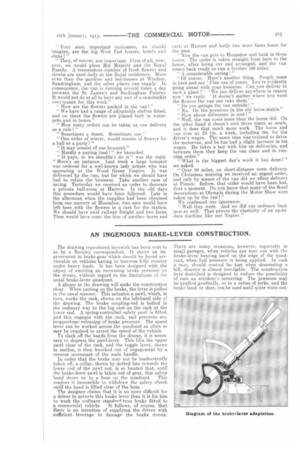AN INGENIOUS BRAKE-LEVER CONSTRUCTION.
Page 7

If you've noticed an error in this article please click here to report it so we can fix it.
The drawing reproduced herewith has been sent to us by a Burnley correspondent.. It shows an improvement in brake-gear which should be found serviceable on vehicles having to traverse hilly country under heavy loads. It has been designed with the object of exerting an increasing brake pressure on the drums, without regard to the limitations of the usual brake-lever quadrant.
A glance at, the drawing will make the construction clear. When putting on the brake, the lever is pulled in the usual manner. This actuates a pawl, which, in turn, works the rack, shown on the left-hand side of the drawing. The brake coupling-rod is bolted in the ordinary way to the lug cast on the rack at the lower end. A spring-controlled safety pawl is fitted, and this engages with the rack, and prevents any inopportune releasing of brake pressure. The speed lever can be worked across the quadrant as often as may be required to arrest the speed of the vehicle.
To slack off the bands from the drums, it is necessary to depress the pawl-lever. This lifts the upper pawl clear of the rack, and the toggle lever, shown in section, is then knocked out of engagement by a reverse movement of the main handle.
In order that the brake may not be inadvertently taken off, a collar, shown by dotted line towards the lower end of the pawl rod, is so located that, until the brake-lever pawl is taken out of gear, this safety band drons on to a boss on the quadrant. This renders it. imnossible to withdraw the safety clutch until the band is lifted clear of the boss.
The designer claims that it is no more difficult for a driver to actuate this brake lever than it is for him to work the ordinary stanciAra-tyne brake fitted to a commercial vehicle. It follows, of course, that there is no intention of supplying the driver with sufficient leverage to damage the brake drums. There are many occasions, however, especially in small garages, when vehicles are sent out with the brake-lever bearing hard on the edge of the quadrant, when full pressure is being applied. In such a case, should control be lost when descending a hill, disaster is almost inevitable. The construction here described is designed to reduce the possibility of such an accident's occurring. The pressure may be applied gradually, or in a series of jerks, and the brake land, or shoe, can be used until quite worn out.






















